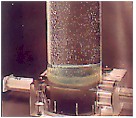Air Void Ananlyzer
(AASHTO TP 75-08)
What is the Air Void Analyzer?
The Air Void Analyzer (AVA) was developed in Europe in the early 1990s by a team headed by Dansk Beton Teknik (DBT). Use of the AVA allows the rapid measurement of air content, specific surface, and spacing factor during concrete placement. This can permit better quality control of critical air-void parameters during concrete placement and optimize concrete performance when exposed to cyclic freezing and thawing.
Background
The use of air-entrained concrete can ensure the durability of moist concrete exposed to cyclic freezing and thawing. Determination of the size and spacing of air bubbles in hardened concrete is traditionally carried out in the United States using methods in ASTM C 457, Standard Test Method for Microscopical Determination of Parameters of the Air-Void System in Hardened Concrete. (Use of the AASHTO and ASTM methods identified here is not a Federal requirement.) Current field air content tests measure the total air content (entrapped and entrained) and therefore will not alert project personnel if concrete has an adequate air-void system, such as bubble size and spacing, for freeze-thaw durability. The AVA measures only the entrained air and not the entrapped air.
Equipment

The AVA equipment typically consists of the following items:
- Plexiglass cylinder (riser column) filled at its base with a viscous (glycerin-based) liquid and topped with water. The bottom of the cylinder is equipped with an access hole to accept the concrete sample.
- Petri dish suspended from a scale’s balance arm.
- A built-in magnetic stirrer and a heater.
- Laptop computer to automate the test procedure and to calculate the air void system.
Procedure
A 20-cc sample of mortar is obtained from fresh concrete and is injected into the viscous liquid and stirred for 30 seconds to release air voids in the mortar. The air bubbles rise through the glycerin and water at varying rates, depending on their size and the viscosity of the liquids. The bubbles collect at the top of the water column beneath a submerged, inverted petri dish suspended from a balance arm. A computer records the change in suspended mass of the petri dish. Knowing the viscosity of the system and using Stokes’ Law, the size distribution of air bubbles with time and the air-void parameters are calculated according to the theory developed by DBT. The DBT theory excludes voids larger than 2-mm diameter from the analysis.
Comments
A provisional test method was adopted by AASHTO in 2008 entitled AASHTO TP 75-08 "Air-Void Characteristics of Freshly Mixed Concrete by Buoyancy change." This provisional test method is based on the Air Void Analyzer. DBT reports that the standard deviation of AVA results is of the same order of magnitude as the standard deviation of ASTM C 457 results.
AVA evaluation tests were conducted under the direction of FHWA (see the archived report FHWA-SA-96-062 "Air Void Analyzer Evaluation" for more details). Comparing the AVA values with ASTM C 457 values, the following observations were made:
- AVA air content was always on the order of 2% less than the air content by pressure meters, ASTM C 231, and ASTM C 457 methods.
- The spacing factor was about the same for AVA and ASTM C 457 methods.
- The specific surface calculated by the AVA was greater than that from the ASTM C 457 test (the AVA indicated smaller air voids than did the ASTM C 457 procedure).
Since the AVA equipment contains a sensitive balance arm scale, the equipment should be set up on a rigid and stable platform. Also, careful handling should occur during operation, storage, and shipping.


